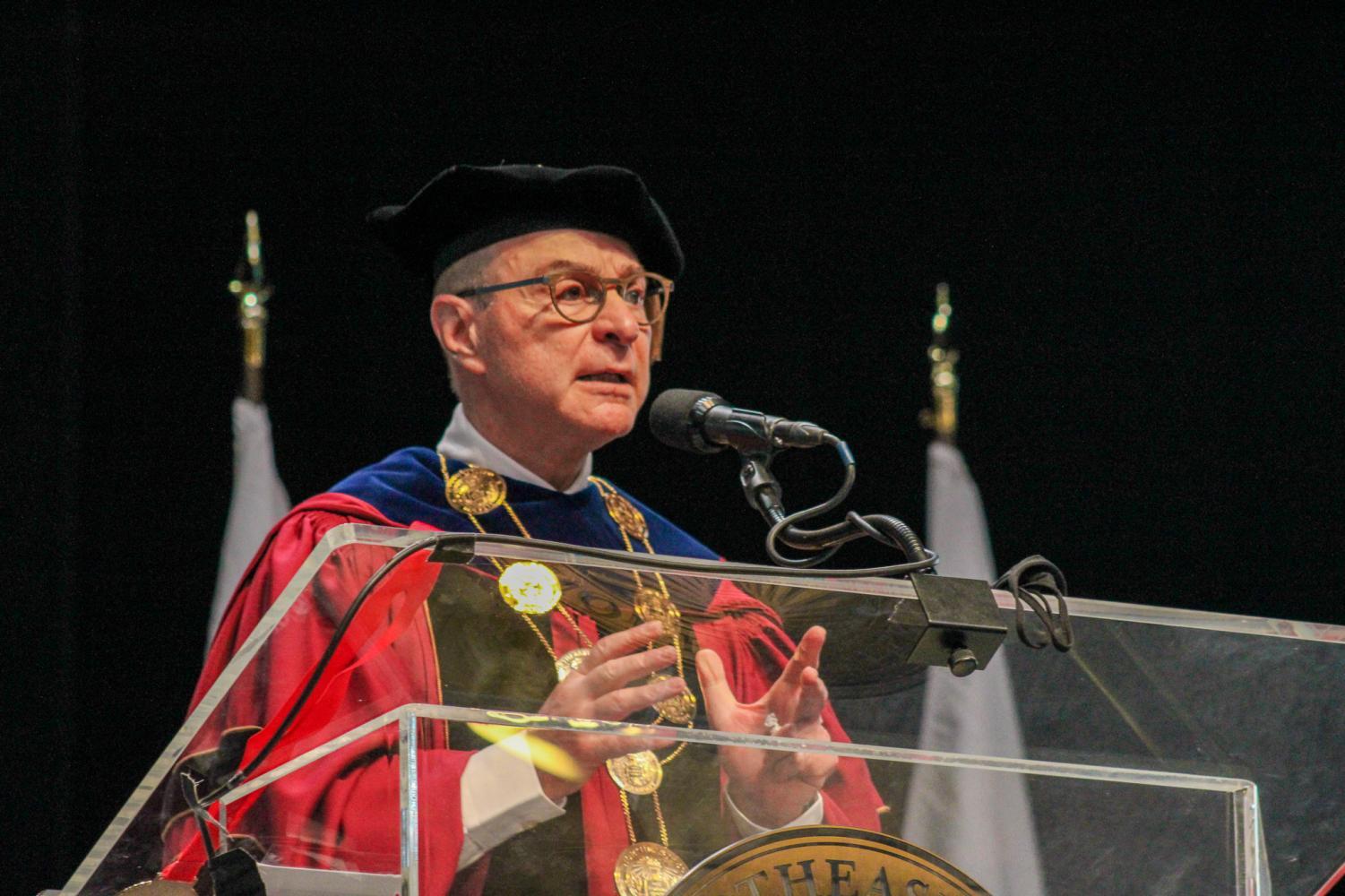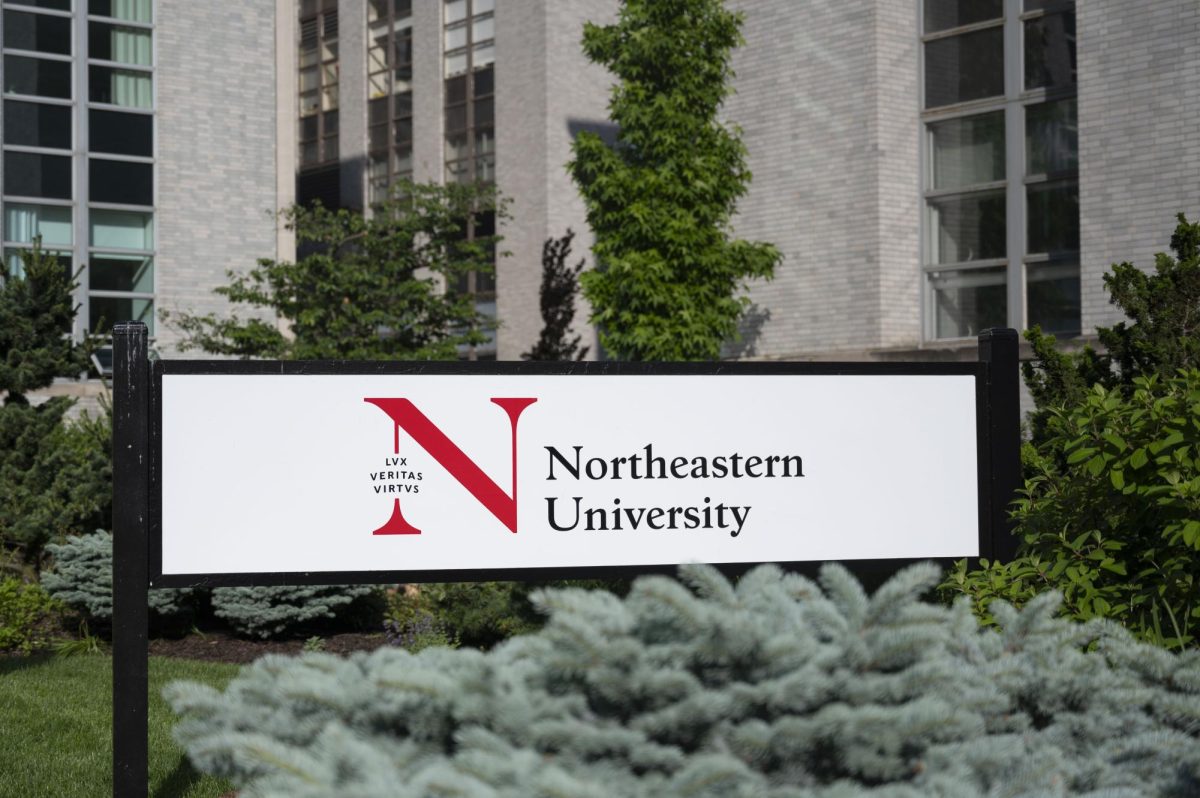In December 2024, an eclectic group of more than 30 powerful CEOs, billionaires and business leaders from across the globe joined Northeastern President Joseph E. Aoun at Northeastern’s Boston campus to outline the university’s top priorities, shaping its framework and future.
The group, Northeastern’s Board of Trustees, is perhaps the most influential entity within the university. But exactly what was discussed last semester — and at every other annual strategic meeting — remains relatively unknown.
While the university’s vision and strategy are ultimately the purview of Aoun and his team of senior vice presidents, the board functions as a “sounding board to test ideas with,” trustee Deborah Dunsire told The Huntington News.
“It’s been an incredibly interesting journey to be a part of,” Dunsire said of her nearly 11 years on the board. When first approached about joining the board, “I didn’t know very much about the university at all,” she said. “I was very interested by [the co-op] model, … President Aoun is one of the most visionary people that I’ve really ever come across.”
University governing boards wield significant power in the world of higher education, yet little is shared about how they function at private institutions. At Northeastern, the Board of Trustees oversees a wide range of issues, from executive salaries to campus expansions.
In an effort to unravel this precise role, The News attempted to directly reach all 32 trustees. Most didn’t respond, and several directed The News to Michael Armini, senior vice president for external affairs. Only Dunsire, the former CEO of biopharmaceutical company Lundbeck, and Anita Nassar, senior managing director of Balyasny Asset Management, agreed to an interview.
The university did not immediately respond to a request for comment on the board’s transparency.
“Visibility is important, and honestly, for Northeastern, I have some trouble with that,” said Kyle Beltramini, a policy research fellow at the American Council of Trustees and Alumni. “I can go to other institutions and I can see what their mission statement is, and oftentimes, on the board websites, I’ll be able to see the board bylaws. I don’t see that in Northeastern, and that can be a problem.”
Northeastern isn’t alone in this — private university boards “are almost always very opaque,” said Eric Kelderman, a senior writer at The Chronicle of Higher Education who covers university governance.
University governing bodies are usually composed of wealthy and successful alumni or others with ties to the institution. Members have a host of responsibilities, including financial oversight and strategic direction, and typically work closely with the university’s leadership.
“It’s always management who proposes the vision and the strategy and the board who oversees it,” Dunsire said. “We’re accountable for testing it, overseeing it, finding out, do we agree that it will get us to the goal that we have for the institution.”
Trustees are not paid by the university but are often donors who strongly believe in the vision of the institution and are expected to hold the university to its articulated mission.
“Trustees are uniquely positioned to act as fiduciaries for that institution because they are not paid by the institution,” Beltramini said. “They are not legally employed by the institution, but they’re lay volunteers serving the institution’s mission.”
One of the most important tasks trustees at all private universities undertake is selecting the university’s president, though all of Northeastern’s current trustees joined the board after Aoun assumed his role in 2006. Presidential evaluation, however, remains a fundamental part of the board’s responsibility.

“Typically, they don’t get involved in details. They hire a good president, they trust the president to run the place and they don’t meddle,” Kelderman said, adding that the board is responsible for giving critical feedback to the administration. “They might offer suggestions, but in general, they’re meant to … have a bigger picture view.”
Richard D’Amore, chair of the Board of Trustees, told The News in a statement that the board’s alignment with university officials has been key to its success.
“Working together, the board and senior leaders have developed strategic plans and a dashboard of metrics to ensure sustained success,” D’Amore wrote. “The results are evident across every dimension of the university’s mission.”
Northeastern trustees skew male and are often alumni, including D’Amore and Alan S. McKim, the namesakes of Northeastern’s School of Business, and Amin J. Khoury, the namesake of the College of Computer Sciences. Other notable trustees include Sir Lucian Grainge, the chair and CEO of Universal Music, and Edward G. Galante, former senior vice president of ExxonMobil.
Two former Mills College trustees joined the board in 2022 after Northeastern absorbed the California school. Only nine of 32 board members are based in Massachusetts, according to The News’ analysis and Northeastern’s website.
Dunsire has no familial or historic ties with the university, she said, apart from a co-op partnership between her company and the university. Nassar, meanwhile, sponsored a scholarship and has a son who attended the university.
“It's like a team — collegial, with a lot of open discussions,” said Nassar, who joined the board in 2015. “We discuss everything or any other issue that needs to be tackled.”
Trustees generally meet five times each year, with four regular meetings and one strategic session, Nassar and Dunsire said.
At each regular meeting, trustees spend one day working in committee and a half day with the entire board to approve different proposals. The board is split into seven standing committees: the Executive Committee, Academic Affairs and Student Experience Committee, Advancement Committee, Audit and Risk Committee, Compensation Committee, Financial Affairs Committee and the Trusteeship Committee. D’Amore and Aoun are ex-officio members of most committees.
The committees’ reaches are broad — the Advancement Committee looks at philanthropic fundraising for the university, for example, while the Compensation Committee helps formulate the salaries of top university leadership. Nassar sits on the Financial Affairs Committee, which delves into the university’s endowments and investments, she said.
“It's a deep dive into each investment we have in the endowment portfolio. It's at least two to three hours and a lot of discussions around how we can optimize those returns,” Nassar said.
Aoun and university leadership may also call a special session of the executive committee to provide emergency guidance. A special session met in April 2024 to discuss Northeastern’s response when students erected a pro-Palestininan encampment on Centennial Common, Dunsire said. These meetings usually include the chairman, the president and chairs of the committees, who can offer “emergency guidance so that we can react in real time to situations that are occurring,” Dunsire said.
“The board will also discuss things like, when a negative article appears or when there were protests last year, ‘How should we handle that?’” Dunsire said.
With larger boards like Northeastern’s, the board chair typically acts as the most frequent liaison with the president and top leadership, Kelderman said.
“Boards hate to be surprised,” he said. “If there's a problem, and it's going to come out in news coverage or some other fashion, the president's going to call the board chair and say, ‘I want to give you a heads up. This is about to happen. Here's what we're doing to handle it.’”
Over the course of the last year, boards of trustees at universities around the country have received increased criticism following leadership turmoil at several Ivy League schools, including Harvard University and Columbia University.
While boards of nonprofits don’t have to answer to a shareholder base as they do with for-profit organizations, “you could be held accountable in the court of public opinion,” Dunsire said, pointing to calls for the leader of Harvard’s board, Penny Pritzker, to resign.
“To some degree, we saw that last year with the protests over Gaza and what happened to some university presidents and boards,” Dunsire said.
The best practice for private university boards is to be transparent about their operations with visibility and communication, Beltramini said.
“One of the big problems that we have is that boards of trustees will try to be a little bit behind the scenes. They may not be as publicly facing as other members of the campus constituency,” he said. “What you'll often get there is that students or faculty members will view these trustees as meddlers. … That's fundamentally misunderstanding the purpose of trusteeship.”
Traditionally, the members of university boards are expected to act outwardly nonpartisan and “keep their politics to themselves,” Kelderman said. But outside of their position on the board, trustees appear free to express political views.
For example, trustee and billionaire James Pallotta, who founded private investment company Raptor Group and formerly co-owned the Boston Celtics, is an outspoken conservative.
Using a personal X account linked to his company’s website, he responded to a post praising former President Joe Biden with a “
Another one of Pallotta’s tweets, responding to another user’s comments about Pete Hegseth, President Donald Trump’s pick for secretary of defense, criticized former President Barack Obama’s “woke political agenda.” Pallotta donated $864,200 during the 2024 election cycle to Republican candidates Nikki Haley and Trump, as well as the Republican National Committee, The News previously reported.
The News’ analysis of publicly available data from the Federal Election Commission previously found that trustees collectively donated $1,176,000 to political causes, 99% of which went to conservative candidates and organizations. Meanwhile, 99% of donations from Northeastern faculty and staff went to Democratic campaigns and candidates in the same two-year time frame.
The demographics of Northeastern’s board are also not representative of the university community. The majority of trustees are white, and 23 of the 32 — nearly three-quarters — are men. This pattern, though, is not isolated to Northeastern: In 2020, nearly 80% of board members at private colleges were white, and 64% were men, according to The Chronicle of Higher Education.
Universities seek out wealthy, influential trustees with top leadership positions, so the lack of diversity on the board is a reflection of the makeup of other industries, Kelderman said. That’s also why the demographics are so slow to change.
“Most of the wealth in our country, and even in European countries, is among white men,” he said. “Those are the folks you go to for donations. Those are the folks that are empowered and have the most prestige.”
Both Nassar and Dunsire acknowledged that Northeastern’s board lacks diversity, but said that it has improved over the past decade. The two newest trustees, Shelley Stewart Jr. and Hemant Taneja, are both men of color.
“Everybody is hurt by this lack of diversity. … It should be 50/50,” Nassar said. “I look everywhere, and it's the same story.”
But the extent to which diversity is prioritized is unknown, as with nearly every other facet of Northeastern’s board. Public colleges are typically required to publish meeting minutes and other internal documents relating to deliberations or decisions. Private universities like Northeastern have no such obligation, despite delegating significant power to trustees.
On Northeastern’s website, the only information available on the board is a three-sentence description, as well as the names and positions of trustees.
Beltramini, who researches best practices for boards of trustees, said that college governing bodies ideally are actively collaborating with their communities. Trustees should position themselves as “engaged stewards,” he added, but too often fall short.
“We really do feel that active, engaged board governance requires that boards collaborate with stakeholders at the institutional level,” Beltramini said. “We need to see boards listening to students.”
Editor's Note: This story was updated Feb. 21 at 12:30 p.m. to correctly identify the responsibility of the Board's Compensation Committee.










